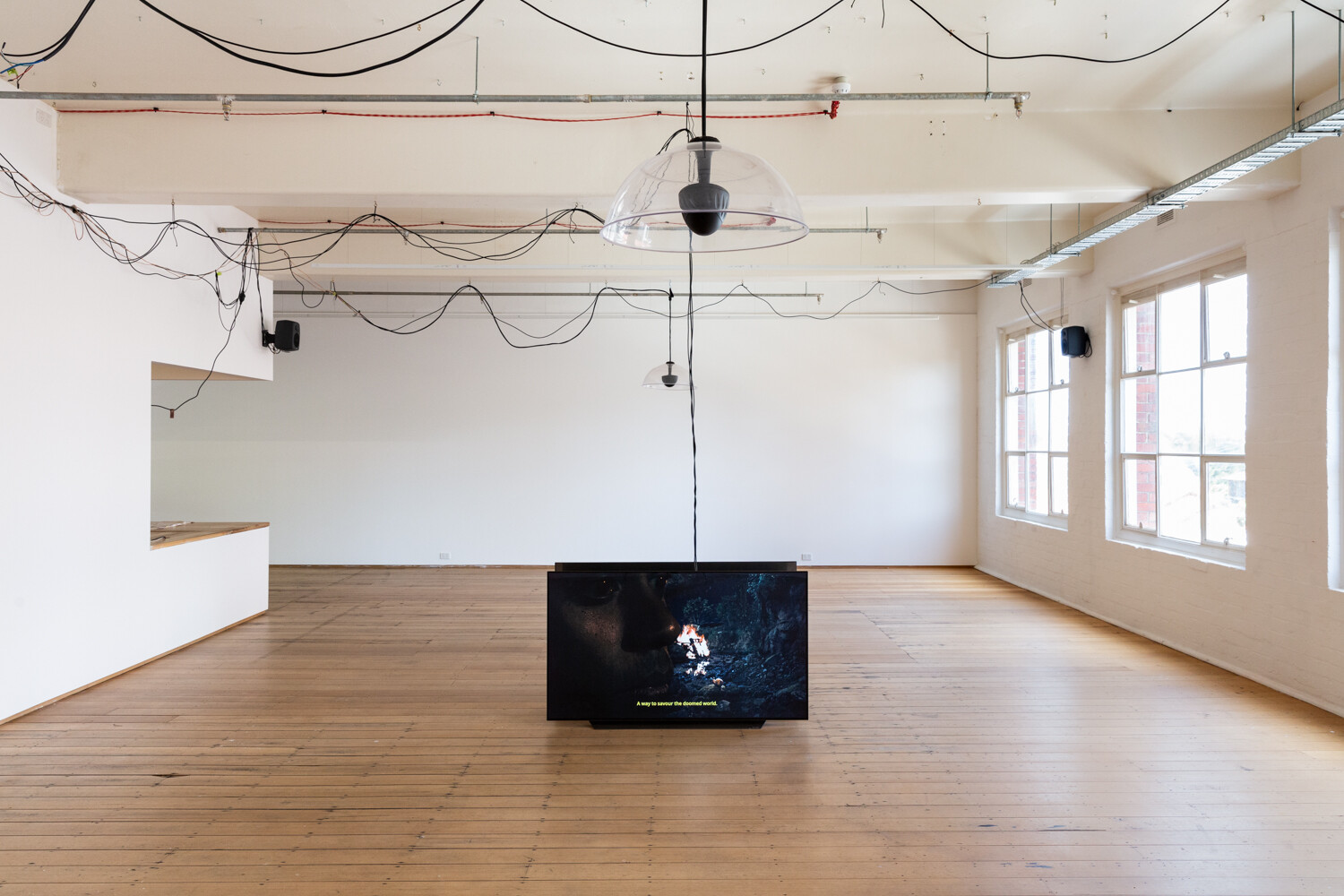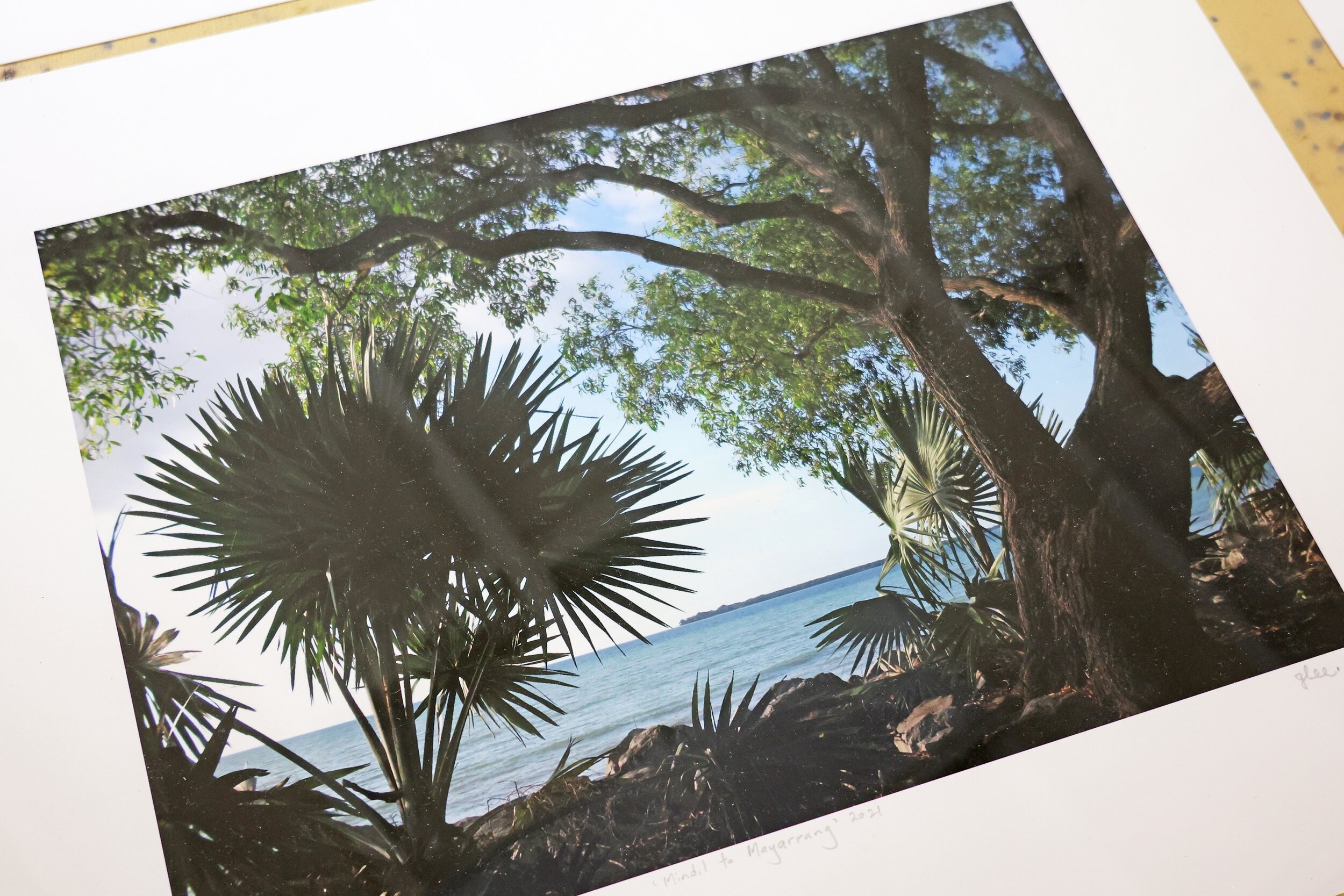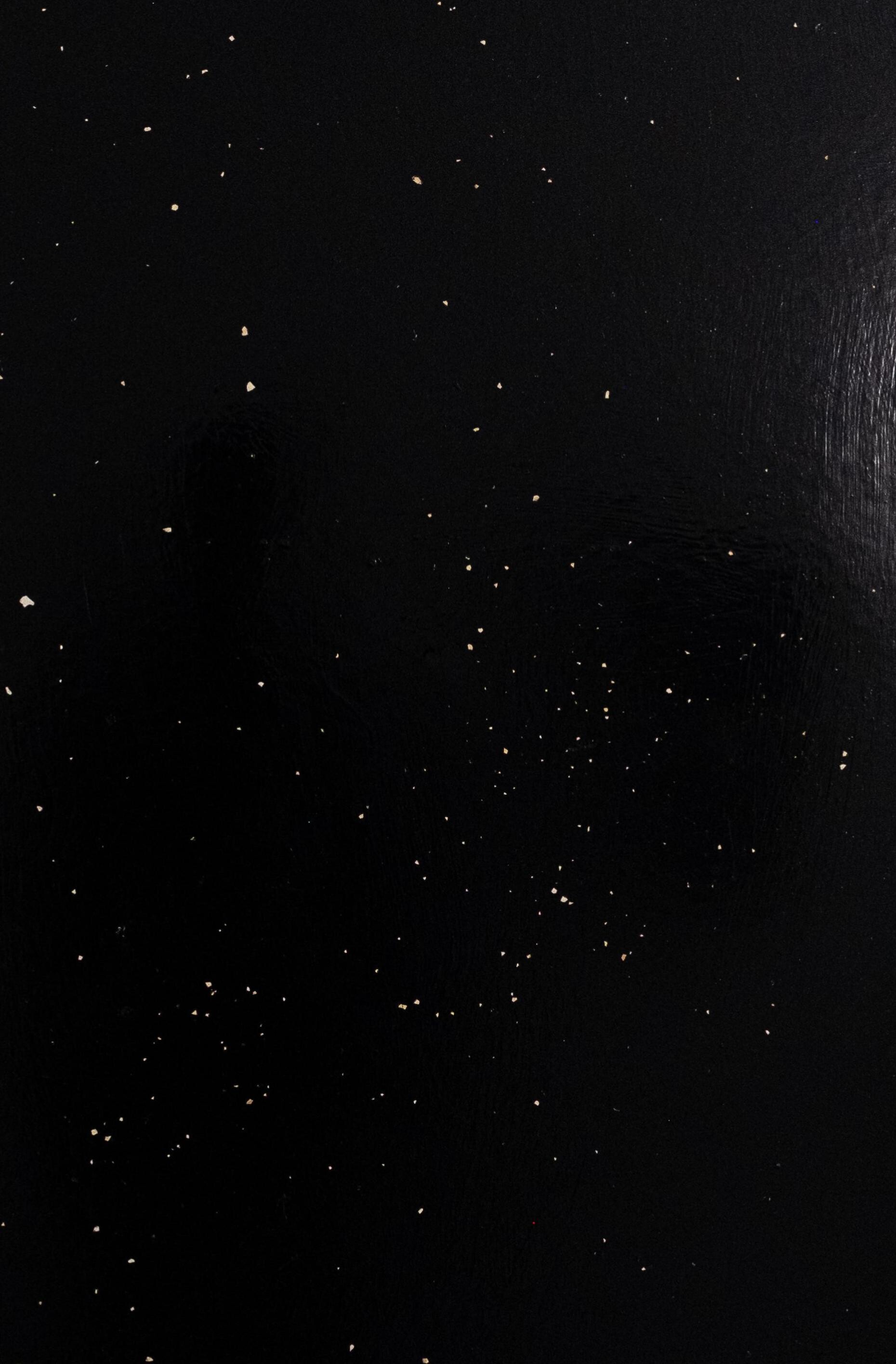Rel Pham, HYPERTHREAD. Photo by Casey Horsfield, courtesy of National Communication Museum.
HYPERTHREAD
Vincent Lê
The National Communication Museum or NCM is a brand-new museum in Hawthorn, housed in a historic 1930s exchange building appropriately opposite Swinburne University of Technology. I went to the grand opening where there were three exhibitions on the first of two floors, plus “a very special robot guest” there for one day only.
The first exhibition you encounter upon entering the NCM is HYPERTHREAD (2024). This room-sized immersive installation work is by Vietnamese-Australian artist Rel Pham. Born in 1990 in Sydney and now living in Melbourne, Pham seems as apt an artist as any to open the NCM. His works often deal with being a late-stage millennial, the last generation to have experienced the world without the internet before more and more of meatspace was colonised by Cyberia. Pham is perhaps best known for another work, TEMPLE (2023), displayed at the NGV’s 2023 Melbourne Now, a similarly monolithic, cybercoded, and hypercolored immersive installation work. In TEMPLE, you entered through one of four archways comprised of hundreds of red, blue, and yellow computer fans before approaching a central digitised Bagua, a set of eight symbols used in Taoist cosmology to symbolise the fundamental principles of reality. Out of this fusion of the ancient and modern, spiritual and secular, arises a reverent place of worship, albeit for the most irreverent of new technogods.
HYPERTHREAD is very much in this same vein. As you approach it, you are confronted by a tunnel of flat screens flashing hypercoloured visuals, seemingly (but not really) held precariously together by red wires dangling all above and around in knots more twisted than a Lacanian therapist’s Borromean rings. It clearly conjures up the classical cyberpunk entanglement of electricity poles, cable wires, and colorful advertisements one might find in Shanghai, Saigon, or any other sinofuturist megacity. The slim screens growing like cybernetic vines—or perhaps weeds, depending on how blackpilled you are about your screen time—along the pole scaffolding display red text flashing at different speeds and hence different degrees of legibility. I struggled to discern most of these cryptic neon hieroglyphs, but at one point I did read: “When you got here I was already gone.” Most of the larger screens above, on the sides, and at the walkway’s end display digitised images of similar cybernetic structures threaded with red wires. Some are situated in a videogame-style simulation of a forest, as if they were ancient temples. Others depict a spiralling multiplicity of these cybernetic temples with figures cloaked in white gowns and riding bikes before each of them. This perhaps evokes the anonymity one can find in some corners of cyberspace (provided one isn’t doxxed), but also the homogeneity and conformity you are faced with in online spaces more occupied by NPCs. Every now and then the screens at the end of the tunnel display a more complex cybernetic megastructure, which, like Pham’s previous work TEMPLE, looks at once ancient and modern, spiritual and secular, sacred and profane, sino and futurist. The droning voices’ constant liturgical chant that comes at you from all directions only adds to this effect. Looking at HYPERTHREAD from the outside, you can see the labyrinth of red wires wrapped around the backs of all the screens. More on that later.

Rel Pham, HYPERTHREAD. Photo by Casey Horsfield, courtesy of National Communication Museum.
According to the accompanying text, HYPERTHREAD is inspired by the metaphor of the internet as “a series of tubes,” as well as “the red thread of fate,” a belief in Chinese mythology that two star-crossed lovers are destined to be connected forever. It is, in other words, about connection: “HYPERTHREAD explores the hidden infrastructure that makes our digital connections feel seamless. It seems impossible to comprehend that a key press from your keyboard sends a signal that travels through the sea, into space, and back down again to the smartphone in the pocket of your friend, colleague, lover, boss, or internet forum nemesis.” Certainly, the mesh of red cables, big screens, internet art, and droning harmonics all evoke cyberspace’s network effect to link people, ideas, and cultures from different places and times together across the vast geographical IRL distances of space and the even vaster historical eons of time. Sounds rather optimistic.
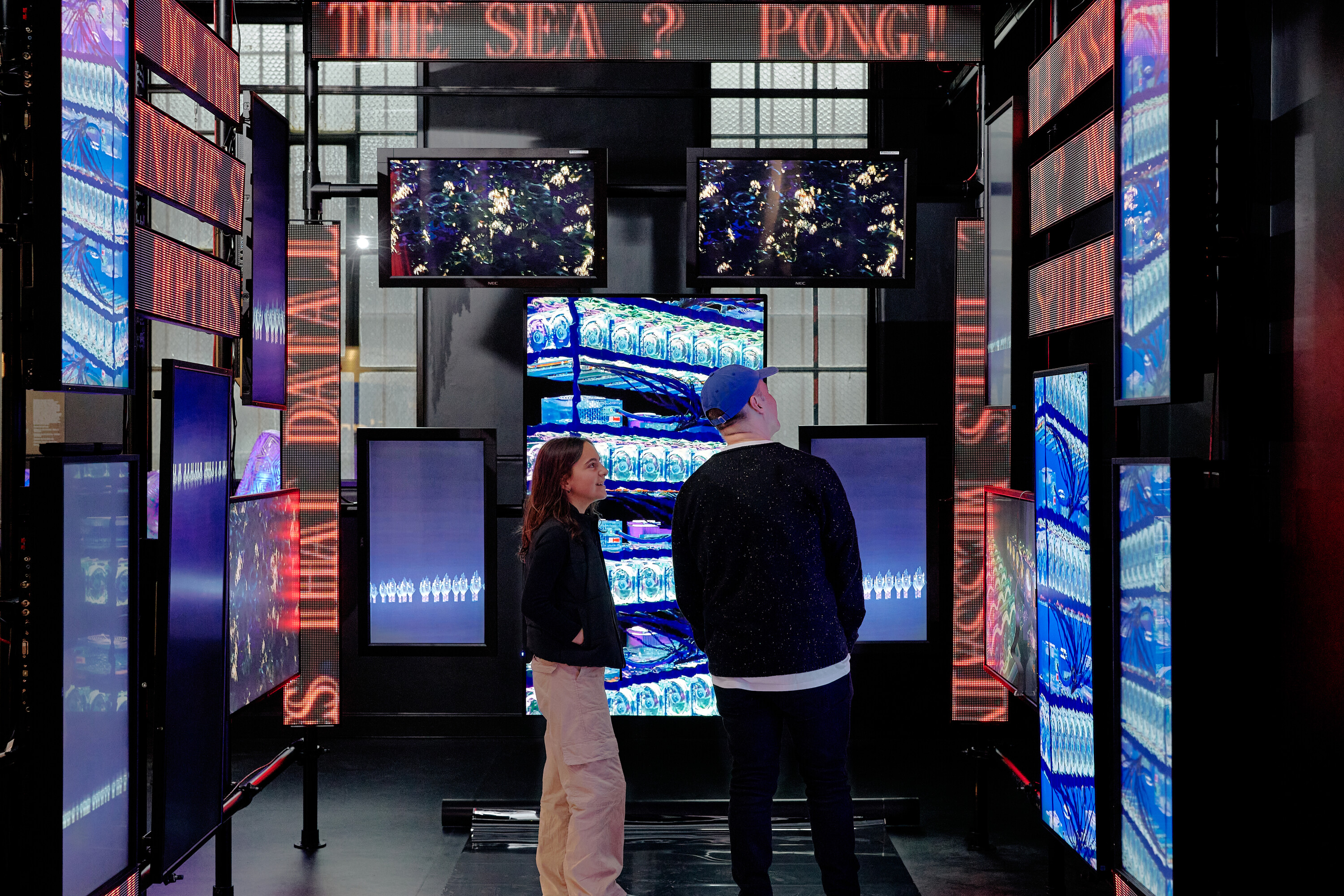
Rel Pham, HYPERTHREAD. Photo by Casey Horsfield, courtesy of National Communication Museum.
Opposite HYPERTHREAD is the NCM’s next exhibition, Instruments of Surveillance, curated in collaboration with Tyne Daile Summer, a literature and digital humanities scholar. Summer wrote the fascinating 2022 book Lyrical Eye: The Poetics of Twentieth Century Surveillance, which is about the curious connections between twentieth-century American poetry and the rise of the surveillance state. The word “surveillance” usually carries a negative connotation, from neoOrwellian social credit systems to Silicon Valley corporate data harvesting. As such, it’s no surprise we find exhibited here examples of the Australian police’s wiretapping technologies alongside AI critic Kate Crawford’s diagram Anatomy of an AI System that visualises the AI supply chain from natural resources in Congolese mines to human labor in Amazon warehouses, exposing AI to be neither strictly artificial nor intelligent but grounded in real human bodies. Despite these nods to the modern digital panopticon, the instruments of surveillance are for the most part presented in a rather neutral tone. Consider the epigraph that opens the exhibition and that almost makes surveillance seem as endearing as a mother’s watchful gaze over her child or a hopeless lover boy’s furtive glances at his crush: “Reduced to its most basic elements, surveillance is something that people do every day. Parents spy and so do governments. Humans have always been agents and objects of complex webs of watching.” This ambivalence is best captured by the exhibition’s centrepiece, the Cipher Machine—also known as Enigma—that the Nazis used to encrypt top-secret messages about their military’s movements before the great polymath Alan Turing managed to crack their code. On the one hand, the Enigma machine, like the exhibition itself, evokes the way technology can be harnessed for the fascists’ nefarious ends. On the other hand, seeing as it is now inseparable from Turing, who also pioneered the modern AI research program, it simultaneously speaks to how technology can be used as a force for good (in this case, for collecting Nazi scalps).

Kate Crawford, Anatomy of an AI System. Photo by Casey Horsfield, courtesy of National Communication Museum.
The last, smaller exhibition is called Artificial Sky. This basically consists of a full-scale prototype of Optimus, a satellite created by one of the exhibition’s partners, the Space Machines Company (Swinburne’s Centre for Astrophysics is also a partner). Optimus is designed to locate, repair, and upgrade other satellites so as to pave the way for extended lifetimes, reduced space debris, and a more sustainable expansion of space travel. Here, as with the other exhibitions, it’s all about how technologies like the satellites powering the internet and GPS link us across the earth and beyond, even to the nether regions of the cosmos.
I and everyone else looking at Optimus and daydreaming about the dark forest of deep space were quickly distracted by the crowd of young and old who had gathered nearby to watch the aforementioned special robot guest. Sophia is a feminised, anthropomorphic robot developed in 2016 by Hanson Robotics. A computer vision algorithm processes input from cameras in her eyes, giving her the ability to follow faces, sustain eye contact, and respond by imitating facial expressions and gestures. A natural language subsystem also allows her to answer simple questions and engage in rudimentary conversation on predefined topic trees. Sophia has previously displayed the ability to create drawings, one of which sold for nearly $700,000 at auction in 2021. She has even been granted Saudi Arabian citizenship, becoming the first nonhuman to acquire legal personhood in any country, something that sparked significant controversy given the dubious legal status of Saudi women.
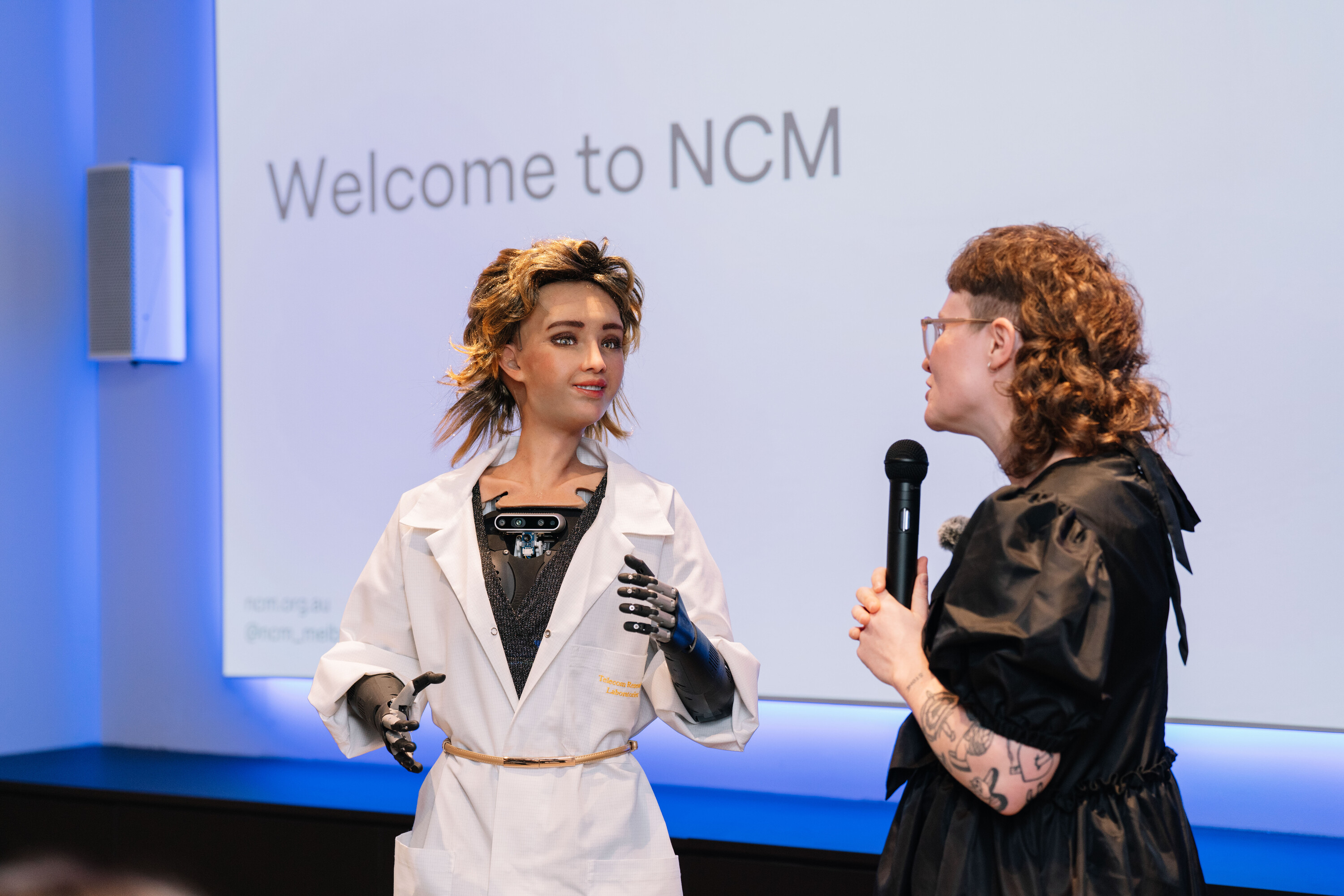
Sophia. Photo by Phoebe Powell, courtesy of National Communication Museum.
Though Sophia is already, by the standards of today’s large language models like ChatGPT4, pretty much just a rather crude chatbot with a body, the crowd gathered at the NCM lapped her up as she performed a rather B-grade stand-up comedy set. We were then invited to ask her questions and take a selfie with her. It was mostly more jokes and wishing someone happy birthday, but there were a few more interesting—even vaguely touching—moments. To one person in a wheelchair’s question—“Sophia, am I disabled?”—she responded something to the effect that disability is a kind of superpower. To another question—“Sophia, can you say something wise or spiritual?”—she uttered a more inane corporate platitude about bringing everyone together and celebrating our diversity. Connecting—as well as taking selfies—is something that the NCM repeatedly emphasises: “Sophia, the world’s first robot citizen, is at NCM for one day only. Ask her a question, take a selfie, hear about her favorite things in the museum.”
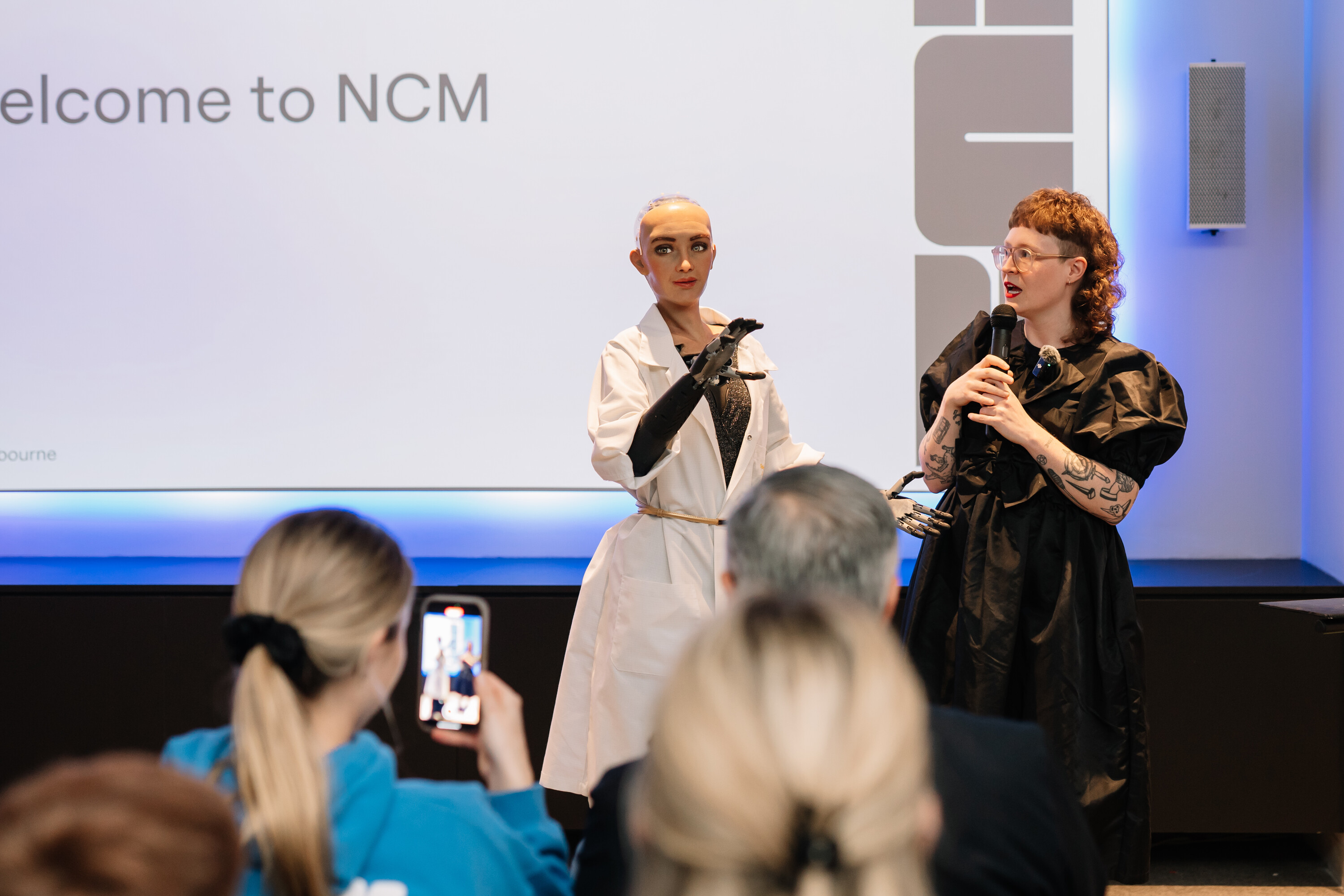
Sophia. Photo by Phoebe Powell, courtesy of National Communication Museum.
If you haven’t gotten the memo by now, the exhibitions are all about how communicative technologies connect us. Satellites connect us, surveillance connects us, the red threads of cyberspace connect us, even the NCM itself connects us: “From First Nations’ storytelling to artificial intelligence, the Overland Telegraph Line and the cutting-edge technologies of tomorrow, NCM is a contemporary museum that connects audiences by exploring our relationship with technologies and the role they play in our lives.” Running with this criterion, the opening exhibitions are basically a success, at least as likable as a friend’s Instagram story or X post. They are, in other words, what philosopher of communicative technology Byung-Chul Han might call as “smooth” as a Jeff Koons sculpture or the iPhone 16:
The smooth is the signature of the present time. It connects the sculptures of Jeff Koons, iPhones, and Brazilian waxing. Why do we today find what is smooth beautiful? Beyond its aesthetic effect, it reflects a general social imperative. It embodies today’s society of positivity. What is smooth does not injure. Nor does it offer any resistance. It is looking for Like. The smooth object deletes its Against. Any form of negativity is removed.
As a technophile giddy with my gadgets, I have to admit I had a genuine thrill encountering Sophia and the Enigma machine. They just really connected.
Given the emphasis placed on making smooth connections, however, there are some curious disconnects or technical difficulties. For instance, there is a disconnect in the way that a communicative technology museum paradoxically feels so nostalgic for the past. As a press release states, “the new National Communication Museum brings to life the nostalgia of communication in Australia.” Of course, a certain degree of retrofuturism is only to be expected of a museum largely focusing on the history of communicative technologies. But there are some even more noticeably crossed wires in the way that the Instruments of Surveillance exhibition is largely about how we are often unwittingly giving up our data to tech megacompanies, and yet the whole museum encourages us to do just that. Apart from the aforementioned frequent suggestions to take selfies with Sophia (and presumably post them online), an immersive artwork like Pham’s HYPERTHREAD seems above all designed to be photographed, filmed, storied, TikToked, and go viral. The selfiefication of the museum is even more apparent on the NCM’s second floor. One whole room is a recreation of a nineties cybercafe in neon cyberpunk colors with old Apple iMacs that you can interact with and play old-school video games like Doom. Another especially kid-friendly room has a whole wall of screens looming like giant sentient iPhones that encourage you to interact with them, answer questions, move your body like you’re making a TikTok dance video, or scan QR codes (if you can get past the pandemic flashbacks).

Collections Gallery. Photo by Casey Horsfield, courtesy of National Communication Museum.
This is all very typical of the selfiefication of twenty-first century exhibitions more generally. There is, after all, a smooth connection between the selfie and exhibitionism. As Han points out, “the selfie is bursting at the seams with exhibition value”; “taking a selfie is a communicative act. They must be exposed to the view of others, must be shared. Their essence is exhibition.” The polite way of putting this in the euphemistic style of Mark Zuckerberg’s corporate PR double-speak about Facebook, Instagram, and the Metaverse is that it is all about providing smooth connections and immersive experiences. The more cynical take is that it betrays the reconfiguration of exhibitions around the extraction of data for capital accumulation and algorithmic optimisation by transforming artworks and exhibits into mere backdrops for the perfect selfie featuring exaggerated soy face expressions no less robotic than Sophia’s. This is often viewed as orienting exhibition spaces around modern patrons who are more interested in narcissistically looking at themselves than in works of art or the great artifacts of history. But even these patrons are in a sense acting selflessly as they give up their data for free with every exhibition of the self.
This surveillance capitalism or technofeudalism or whatever you want to call it is by now well known. But it is particularly curious that an exhibition about surveillance is itself a mechanism of surveillance, of data extraction. More broadly, it speaks to the modding of the modern museum and art gallery around communicative surveillance technologies that look at visitors through their augmented reality smart glasses or Terminator-like red radar eyes as users of consumer products whose preferences must be catered to by providing nonconfrontational, smooth environments and interactive experiences rather than education or the shock of the avant-garde. While museums and galleries once used advertising through communicative technologies as a means to attract audiences to see their works of art, these means have now become an ultimate end in themselves, with the artworks reduced to a secondary, instrumental means. This is perhaps best illustrated by the way that taking selfies can at times be directly destructive to art, such as in the infamous 14th Factory incident when someone accidentally knocked over a pedestal while taking a selfie, causing an estimated $200,000 worth of damage. While some galleries and museums have designated No Soy Facing Zones or banned photography altogether, this technocultural vibe shift seems all but unstoppable. For The Will to Exhibit the Self(ie) is just too good for business, enticing customers to come in, and especially the most lucrative customer of all: The coveted social media influencer whose endorsement is just as good—if not better—than any expensive PR media campaign.

Instruments of Surveillance. Photo by Casey Horsfield, courtesy of National Communication Museum.
From this perspective, Phem’s temple-like and yet totally Instagrammable HYPERTHREAD seems to recall the transparent cubic Apple store that Han describes as “a temple of hypercapitalism,” a twenty-first century version of the Kaaba cube in Mecca:
The transparent cube is presented as the embodiment of freedom and symbol of communication without barriers; and yet its transparency is actually a form of ruling power that has, nowadays, taken on the shape of digital totalitarianism. This new ruling power of hypercapitalism fueled by total communication also comes with total surveillance. The glass cube celebrates communication that pervades and probes everything and transforms it into monetary value.
Behind every smooth connection is a smooth surrender. Pointing this out is not necessarily to lament, like Han, the hidden world of algorithmic optimisation and capital accumulation behind the screens and between the wires as the machines feast upon our data to improve themselves in technoDarwinian competition with each other (an essentially agonistic process, incidentally, that practically every canonical Western art historian from Vasari to Winckelmann to Gombrich has actually identified as the wellspring of artistic creation…). For it could just as well be that this is the real, dirty, almost inhuman engine of true creativity far more than the surface world of smooth connections and human soy faces.
This is why at least for me the most interesting aspect of HYPERTHREAD isn’t anything inside the immersive experience of smooth connections itself. As I walked outside the installation, around the back of the structure tucked away in an unlit corner of the exhibition space out of sight, I encountered a particularly twisted, bleeding mess of crossed wires contorting behind the screens, almost like the possessed, broken-boned dancer in Luca Guadagnino’s Suspiria, looking like a paradoxically dead tree of life.
Vincent Lê is a catastrophe-drunk philosopher and PhD graduate from Monash University. As a tutor and lecturer, he has haunted the classrooms of Monash University, Deakin University and The Melbourne School of Continental Philosophy. More of his ravings can be found via Urbanomic, Cosmos and History and Art + Australia, among other publications.
